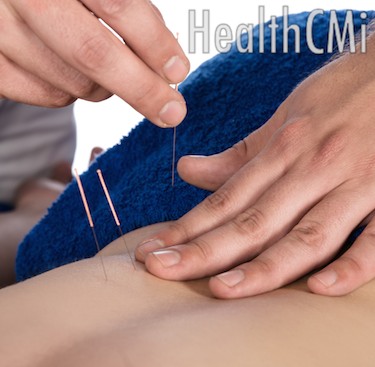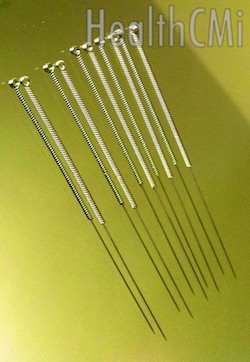A new study finds acupuncture combined with massage is more effective for treating lumbar disc herniation (LDH) than coenzyme B12 injections combined with physiotherapy. Researchers from Guangxi Jiangbing Hospital randomly divided 60 patients with LDH into an acupuncture group and an injection group. The acupuncture group received acupuncture needling on myofascial pain related trigger points combined with massage.  The injection group received coenzyme B12 injections combined with traction and heat therapy. The acupuncture group achieved an overall effective rate of 96.7% and the injection therapy group had an 80.0% effective rate.
The injection group received coenzyme B12 injections combined with traction and heat therapy. The acupuncture group achieved an overall effective rate of 96.7% and the injection therapy group had an 80.0% effective rate.
A lumbar disc herniation is a condition of the lower spine that frequently affects young and middle-aged patients. The discs are spongy cushions between vertebrae that act as shock absorbers. A rupture of a disc’s outer fibrous ring (anulus fibrosus) allows the soft jelly-like center to extrude through the tear. This may impinge nerve conduction and cause severe pain or may be asymptomatic. Inflammatory chemical mediators are often released as a result of a herniation and may lead to pain, numbness, weakness, an antalgic gait and impaired range of motion. The normal aging process is often accompanied by a loss of disc hydration and consequent disc collapse. This increases strain on the fibers of the annulus fibrosus surrounding the disc thereby facilitating a herniation of disc material. Sudden injuries to the spine also precipitate this condition.
In Traditional Chinese Medicine (TCM) theory, lumbar disc herniation is often categorized as an illness of low back pain, numbness syndrome and/myofascial pain syndrome (MPS). The latter is characterized by trigger point and muscular tension. TCM trigger point treatment of MPS may involve stretching the affected muscle region following by stimulating trigger points in the damaged region. Both local and distal acupuncture point prescriptions are appropriate for the treatment of lumbar disc herniation. This investigation focused on the study of trigger point therapy.
Local acupuncture points used for the treatment of lumbar disc herniation are often in the region of the Taiyang channel, Du channel and Huatuojiaji points. The excitable trigger points are typically probed on the gluteus maximus, gluteus medius, piriformis, upper hamstring, tensor fasciae latae, vastus lateralis muscle, tibialis anterior and the gluteus minimus. The trigger points are similar to ashi points and their locations often overlap.
The researchers chose acupuncture points based on palpation and visible inspection of cord-like spasms, hardened areas and ahshi points of the lower back. Filiform acupuncture needles were inserted and withdrawn through various layers to detect and treat damaged regions. After deqi sensation was achieved, the treated muscle would convulse and vibrate. The needling was of medium strength and applied until the convulsion and vibration disappeared. 
During massage, the patient rested in a prone position. The therapist massaged the patient’s lumbosacral portion and the back side of limbs several times; applied acupressure to UB23, UB54 and the two lines along the Bladder Channel; or applied acupressure to UB23, DU3, GB30, BL40, UB57, UB60, ST41 and other related points. Alternatively, the patient rested on one side with the affected limbs on top, bending both knees and hips. The therapist used one arm and elbow to push the hip on the affected side and used the other hand to support the shoulder on the affected side. The therapist applied a pushing and pulling motion and then patted the patient’s lower back until it felt hot. The massage lasted for 20-30 minutes. Acupuncture and massage were applied once per day for a period of seven days, comprising one course. There was a three-day break between courses. The entire treatment consisted of three courses.
The injection group received intramuscular injections of 1.5 mg cobamamide (coenzyme B12) and oral administration of 840 mg Pagosid (Devil’s Claw) once per day. For physiotherapy, the group received lower back traction three times per day and heat physiotherapy of low to medium intensity on the lumbosacral region for 20 minutes per day. One course consisted of seven days and the entire treatment consisted of three courses.
After the treatment, 20 patients in the acupuncture group fully recovered, seven showed marked improvement, two showed moderate improvement and one showed no improvement. The overall effective rate of the acupuncture group was much higher than that of the injection group. According to the JOA scale and Visual Analogue Scale (VAS), the acupuncture group also significantly outperformed the injection group. Based on the above outcomes, the researchers concluded that trigger point acupuncture combined with massage is a superior approach to LDH treatment compared with coenzyme B12 injections combined with physiotherapy.
About HealthCMi
The Healthcare Medicine Institute (HealthCMi) publishes news, research and acupuncture continuing education courses online. Courses are valid for NCCAOM Diplomate PDAs, acupuncture CEUs, CAEs and CEs throughout the USA and Canada. Musculoskeletal pain related courses include the treatment of wrist pain, plantar fasciitis, fibromyalgia and more. Enjoy our online course offerings and get your acupuncture license renewal credits now. All courses are also approved for California nursing continuing education contact hour CEUs.
Reference:
Mai, Lei, Qianyang, Li. “Efficacy Observation on Acupuncture on Trigger Point of Myofascial Pain Combined with Massage Treating Lumbar Disc Herniation.” Chinese Manipulation & Rehabilitation Medicine, 5.3 (2014): 80-81.


